 Пт, 27 май 2016 Автор: Эльвира Корчагина
Пт, 27 май 2016 Автор: Эльвира Корчагина
Asparagus beans (tursha) – high-yielding annual, not
widespread in suburban areas.
And in vain.
This culture is easy to grow and unpretentious to care.
Contents
Why is it worth growing green beans on the backyard
plot?
Tursh is a profitable crop for cultivation. The following are described
7 основных «плюсов» ее выращивания на приусадебном
plot:
1. The fiberless structure and delicate taste of young pods (their
Also called shoulder blades) and their high nutritional value (in terms of
protein beans exceeds the fish, it consists of about 30
amino acids, the tea from the valves of the beans has a healing
properties);
2. High yield (with proper agrotechnology from one
plants during the growing season can collect 3-5 kg of blades);
3. Long fruiting period;
4. Easy care;
5. Decorative quality – thanks to the ability to quickly
increase the green mass, against which the “scattered” bright
spotted yellow, purple, red or white flowers, beans can
use for landscaping the site;
6. Increases soil fertility – asparagus beans, like others
representatives of the legume family, due to nodule bacteria
fixes and accumulates nitrogen in the soil;
7. As protection against wind and moles – lush green asparagus
beans creates an openwork shadow and protects against wind gusts such
tender crops like cucumbers and tomatoes. To this end, it is planted with
south side of the garden beds or around the greenhouse. Moles and shrews are not
love the smell of beans and bypass the areas around the perimeter of which
planted this culture.
Asparagus beans: planting, variety selection
Selection and preparation of the seat
For the cultivation of asparagus beans choose a sunny place with
protected from cold northerly winds. Light slope is best
The terrain is southwest or south. Soils this culture prefers
fertile loose. Heavy soils or lowland wet areas for
Cultivation of beans are not suitable.
The plot begins to prepare in the fall. When digging make
organic (5-7 kg / m2 of humus) and mineral fertilizers:
potassium chloride (20g / m2), superphosphate (30g / m2). Nitrogen supplements
it does not need it – it accumulates in the soil itself as a result
symbiotic interaction with nodule bacteria.
An excess of nitrogen will lead to an intensive growth of green mass in
damage to fruiting – decreases the number of ovaries formed,
pods are formed small.
The best predecessors for asparagus beans are
solanaceous (tomatoes, potatoes, eggplants), all kinds of cabbage,
root vegetables (beets, carrots, root parsley, celery),
cucumbers.
Growing methods
Depending on the type of green beans, there are different ways
growing this crop. Bush varieties
planted in small rows or staggered. Interval
inter-row spacing is 0.4-0.45 m, and in the row between the plants –
0.2-0.25 m.
For curling beans you need to prepare a support.
Grow it in such ways:
• Gnezdovoy – 9-12 are planted on a round bed with a diameter of 0.8-0.9 m
beans and constructing a structure of stakes by type of hut;
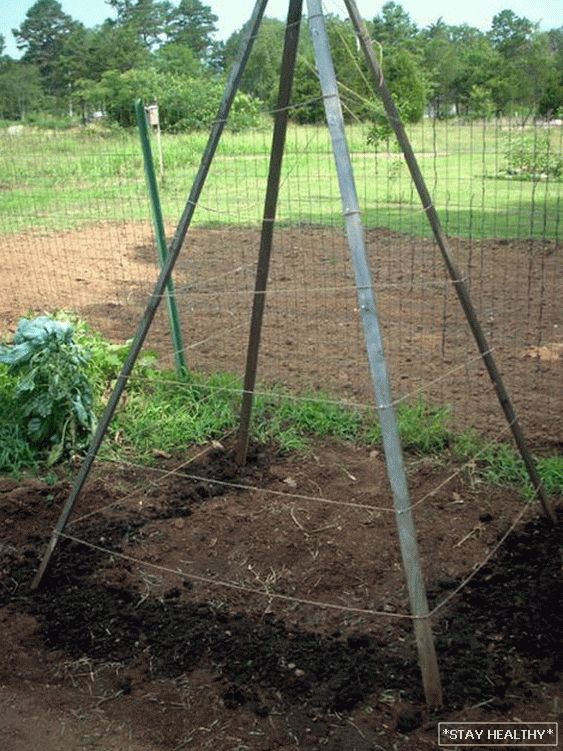
Stake support in the form of a tent
• On a trellis with strained ropes – this is the most optimal
option for liana beans. Every plant is provided
maximum amount of light, food area, good
ventilated (i.e. reduced risk of developing rot). Also when
This method of cultivation is much easier harvesting –
the pods are visible;
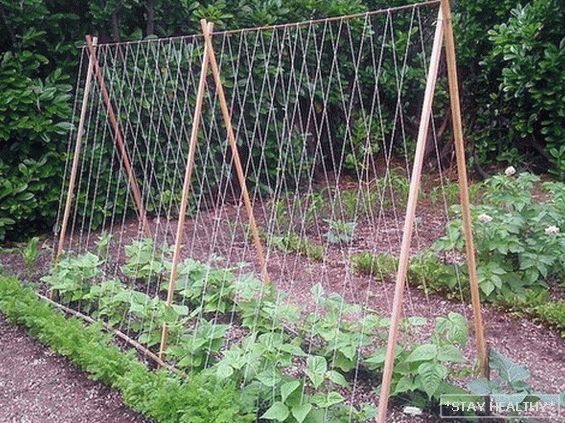
Rope trellis for curling asparagus beans
• Along the walls of buildings, fences – clinging to these supports, beans in
the growth process forms spectacular “green carpets”, giving
additional decorative area.
Terms and technology of sowing in the ground
In open ground, asparagus beans are sown depending on
climatic conditions of the regions: in the middle lane is the second
half of May, when the threat of frost had passed, in northern areas
– the beginning of June, in the south – the second half of April. Soil to this
the time is heated at a depth of 10 cm to + 8-10 ° C.
Planting includes the following
stages:
• Sorting beans – for planting choose whole intact
seeds;
• Selected grains are left to swell in warm water on
10-12 hours;
• Swollen seeds are planted in a prepared place at a depth of 4-5
cm on light soils and 2-3 cm on loams;
• After sowing, the bed surface is mulched with humus. If a
there is a threat of freezing, you will need a shelter film;
• Shoots appear 7-10 days after sowing. If a они густые,
they are thinned, keeping 10-25 cm between plants in a row. AT
This period is carried out by loosening the row spacing. Aeration of the soil
helps to enhance the life of nitrogen-fixing
nodule bacteria and as a result of this better development
plants;
• When the bushes reach 10 cm in height, they are low
spud.
AT северных регионах для сокращения сроков получения урожая
It is recommended to grow seedlings at home or in greenhouse.
It is better to plant beans immediately in disposable peat cups so that
when landing on a garden bed, do not destroy the earthen room – beans are bad
tolerates root damage.
ATыбор сорта
For growing green beans in temperate regions
it is better to use varieties of early and mid-season, harvest with
which can not only be eaten immediately, but also procure
for the winter (freezing and preservation).
The most popular varieties among gardeners are presented in
table:
|
Terms of ripening |
Plant shape |
Grade name |
|
Early maturing (45-60 days) |
Bush |
Crane, Serengeti, Oil King, Octave, Triumph764, |
|
ATьющаяся |
Blue Hilde, Gold Mary, Korean Woman, Rumba |
|
|
Mid-season (55-80 days |
Bush |
Panther, Note, Korlevsky purple pod, Polka, Dewdrop, |
|
ATьющаяся |
Снежная королева, Гармония, ATигна Графиня, Макаретти, Пурпурная |
Asparagus beans: care (photo)
After the asparagus beans have sprung up, caring for it
consists in watering, loosening and weeding, making
fertilizer and pest control. Beans are pretty unpretentious and
drought-resistant, but with a lack of moisture the ground part is bad
evolving, the pods shrink and deform. It is better to water early
in the morning or in the evening under a bush. After watering must be carried out
loosening the ground around the bushes so that the soil does not form
crust. To preserve moisture in the beds and reduce the amount of
weeds between rows can be mulched.
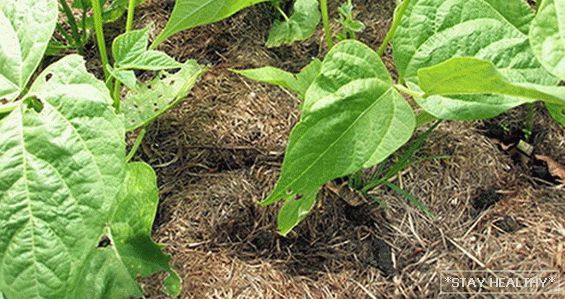
Bed with asparagus bean mulched straw
Climbing varieties pinch to increase the number of ovaries.
tops at the level of 2-2.5 meters.
Asparagus beans: top dressing
During the growing season, asparagus beans are fed a few
time. AT связи с тем, что эта культура сама аккумулирует азот в
soil, an excess of this substance is harmful to it. Therefore organic
(5-7 kg / m2 of rotted manure or compost) is brought in the fall under
digging If a почва на участке малоплодородная песчаная, то
nitrogen fertilizers are applied in the spring (for example, ammonium nitrate 20-30
g / m2).
AT период бутонизации добавляют фосфорно-калийные комплексы:
potassium chloride (20g / m2), superphosphate (30g / m2). To form
pods plants need an increased amount of magnesium, phosphorus
and potassium. These elements are found in large quantities in woody
ash: it is scattered in a thin layer around the bushes. Simultaneously she
will protect the bean bushes from the raids of slugs and snails. After
первой волны цветения фасоль подкармливают еще time.
Asparagus beans: harvesting
Terms of ripening pods depends on the selected variety:
early maturing is harvested 45-60 days after sowing, mid-ripe
55-80 days, late ripening – 90-130 days. To stimulate
the formation of new ovaries and increase the yield, it is necessary to collect more often
paddles (pods) – 7-8 days after flowering. By this time
fruits reach milky ripeness (without coarse fibers) and to taste
resemble young asparagus. Blade removal stimulates second wave
flowering Thus, you can harvest until late autumn. AT
fresh asparagus beans are stored for long, better than her
use directly for food, preserve or
to freeze.
Asparagus beans: diseases and pests (photo)
The most common disease of asparagus bean (and all
бобовых) является антракноз, который поражает
plant on all phases of its development. The leaves turn brown and fall, their
scapes and stems covered with dark stripes on the pods
rusty depressed spots appear with pinkish growths.
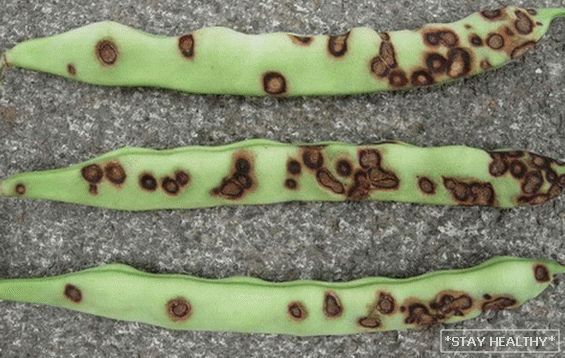
The manifestation of anthracnose on the pods of beans
The disease is spread by wind in wet weather. To combat
crop must be observed with anthracnose (plant beans on one
plot only after 4-5 years), in the fall to destroy the plant
leftovers and dig up the soil, cultivate early maturing varieties.
Белая гниль — еще одно заболевание грибковой
etiology. It is characterized by softening of the pods and the formation of
on them white bloom. Since mid-July, stalks are also affected.
plants.
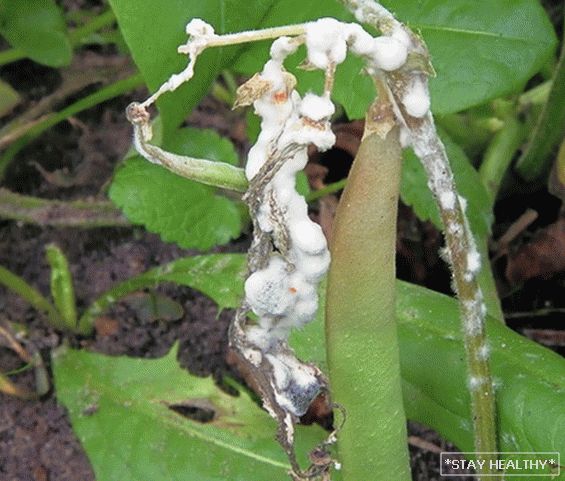
White-rotted pods of beans
The progression of rot contributes to a humid climate. For
prevention of this disease, infected plants are removed from the garden, not
allow thickened plantings, increase the dose of potash-phosphorus
fertilizer pods are collected from dry weather.
Из вирусных недугов фасоль подвержена желтой
мозаике, переносчиком которой является тля. Leaves
acquire a chlorotic appearance – appear on a basic green background
patches of yellow color of different color intensity. ATозможна
deformation of the pods. Treatment can not be. AT качестве
Prevention measures shown fighting aphids (spraying
insecticides), weed control.
Of bacterial diseases, beans often become infected.
бактериозом (угловой пятнистостью). Everyone is amazed
elevated parts of the plant: oily spots are formed on them by wound
shape and size. AT результате растения быстро засыхают.
The following pests parasitize the beans:
• галлица гороховая — повреждает семена,
flowers, beans;
• долгоносик клубеньковый — взрослые насекомые
eat the edges of the leaves, the larvae feed on nitrogen-containing
nodules;
• фасолевая зерновка — имаго кормятся пыльцой и
blooms, larvae damage pods and beans;
• тля является переносчиком вирусной желтой
mosaics.
To combat этими вредителями используют инсектициды.
AT качестве защиты от слизней и улиток,
eating young plants (especially bush varieties), land
around the plants sprinkled with lime, wood ash, pine needles,
set traps or use granular preparation
Thunder.





